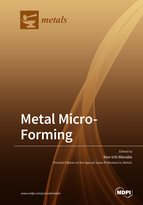Metal Micro-forming
A special issue of Metals (ISSN 2075-4701).
Deadline for manuscript submissions: closed (29 February 2020) | Viewed by 44434
Special Issue Editor
Interests: deformation mechanics & process simulation; intelligent forming process; materials processing; micro-forming
Special Issues, Collections and Topics in MDPI journals
Special Issue Information
Dear Colleagues,
Micro-forming of metals is an excellent technology as a mass production method with high productivity and good mechanical and functional properties to manufacture very small parts. This technology has attracted much attention in the manufacture of metallic micro parts in electronics, the biomedical industry, the communication industry, and so on.
So far, several metal forming processes have been achieved by scaling down the process configuration, the dies and tools, and the forming machines. There are, however, several technological issues related to the occurrence of size effects due to miniaturization. Major issues include understanding materials properties and the deformation mechanism, micro-formability and -forming limits, material/tool interfacial conditions, process modeling and analysis, process design optimization, etc. Moreover, to achieve high micro-formability and high dimensional accuracy, novel special micro-forming techniques combined with the laser system, ultrasonic vibration, special heating, or ultra-high pressure have been developed.
The aim of this Special Issue is to present the latest achievements in various metal micro-forming processes and the latest research related to the elucidation of size effect. Through this Special Issue, enhancing the understanding of the present status and trend of metal micro-forming technology and further promoting are expected. Thus, all researchers in this field are invited to contribute.
Prof. Emer Dr. Manabe Ken-ichi
Guest Editor
Manuscript Submission Information
Manuscripts should be submitted online at www.mdpi.com by registering and logging in to this website. Once you are registered, click here to go to the submission form. Manuscripts can be submitted until the deadline. All submissions that pass pre-check are peer-reviewed. Accepted papers will be published continuously in the journal (as soon as accepted) and will be listed together on the special issue website. Research articles, review articles as well as short communications are invited. For planned papers, a title and short abstract (about 100 words) can be sent to the Editorial Office for announcement on this website.
Submitted manuscripts should not have been published previously, nor be under consideration for publication elsewhere (except conference proceedings papers). All manuscripts are thoroughly refereed through a single-blind peer-review process. A guide for authors and other relevant information for submission of manuscripts is available on the Instructions for Authors page. Metals is an international peer-reviewed open access monthly journal published by MDPI.
Please visit the Instructions for Authors page before submitting a manuscript. The Article Processing Charge (APC) for publication in this open access journal is 2600 CHF (Swiss Francs). Submitted papers should be well formatted and use good English. Authors may use MDPI's English editing service prior to publication or during author revisions.
Keywords
- Micro bulk forming
- Micro forming of thin sheets and tubes
- Micro blanking
- Micro rolling
- Micro tribology, Surface texturing
- Die and tool materials
- Microstructure
- Materials evaluation testing method
- Process simulation model and analysis
- Novel micro processing






